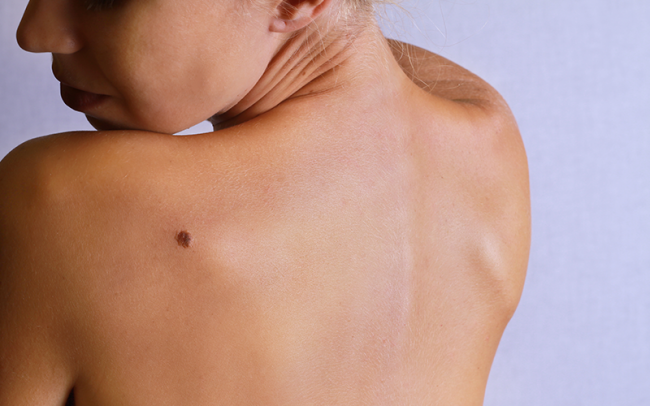Nodular melanoma is an extremely dangerous and fast-growing form of melanoma, the deadliest form of skin cancer. Though only a small percentage of melanomas are considered nodular, they cause almost half of all melanoma-related deaths.
The good news is that if nodular melanoma is diagnosed early, there is a higher chance of it being cured. Here’s what you need to know about nodular melanoma, so you can recognize the signs before it advances.
What Does Nodular Melanoma Look Like?
Nodular melanoma is a deadly type of skin cancer that typically appears on the areas of skin most exposed to the sun such as the legs, chest, back, arms and head. This type of melanoma usually appears as a round, black bump, but it can also look like a mole or even a pimple with no pus inside.
Nodular melanoma can affect anyone, at any age, but it is most typically found in men over the age of 50 who have a family history of skin cancer, pale skin or numerous moles. Unlike other skin cancers that can usually be detected by asymmetry, uneven borders, and unusual coloring, nodular melanoma is often a round, black (and sometimes blue, gray, red or white) bump. In rare cases, nodular melanoma can even be flesh-toned or pin, but it is almost always a solid color with even borders.
Similar to other types of skin cancer, the main cause of nodular melanoma is UV exposure, though it can also develop on parts of the body that don’t receive a lot of sun exposure.
Melanoma is the deadliest form of skin cancer. Though it only accounts for 4% of all skin cancer cases, melanoma causes about 79% of skin cancer deaths. It begins in the melanocytes, the cells that produce the pigment melanin.
What makes nodular melanoma so dangerous is that it grows quickly, affecting the surrounding tissue, bones and even lymph nodes in a matter of weeks or months.
“Melanoma is rare, and nodular melanoma is even rarer. Most cases can be directly linked to exposure to UV rays, though genetics and an individual’s family history can also contribute to the risk of developing skin cancer,” says Dr. Sital Patel, a board-certified dermatologist with U.S. Dermatology Partners Four Points
How to Treat Nodular Melanoma
Treatment of nodular melanoma depends on the stage of the cancer and how far it has spread when it is diagnosed. Your dermatologist can take a quick biopsy of the suspicious bump — and sometimes a biopsy of your lymph nodes as well — and send the samples to the lab for a definitive diagnosis.
If the cancer is in its earliest stage, a surgeon can often remove the nodular melanoma, as well as some of the surrounding healthy skin, before it spreads to other organs of the body and becomes more difficult to treat.
If the cancer is discovered in a later stage and has already spread, it can be treated with lymph node surgery, chemotherapy, radiation therapy or immunotherapy in some cases. There are even some targeted therapies on the market today that use specialized drugs to target certain melanoma cells.
How to Prevent Nodular Melanoma
Skin cancer is the most common form of cancer in the U.S. with more than 3.5 million cases diagnosed each year. It is caused by the uncontrolled growth of abnormal skin cells that occurs when skin cells suffer DNA damage and then mutate and multiply, developing into malignant tumors.
More than 90% of all skin cancer is caused by long-term exposure to UV radiation. If you have fair skin and light-colored eyes, a history of sunburn early in life, a history of skin cancer or precancerous lesions, or if you use tanning beds, you are at a greater risk of developing skin cancer. Those who spend a lot of time in the sun or have multiple moles or abnormal moles are also at a greater risk.
The best way to defend against nodular melanoma and other forms of skin cancer is to protect your skin from the sun’s damaging UV rays. The most important and effective thing you can do to prevent skin cancer is to always wear a quality sunscreen with an SPF of 30 or higher. When swimming, allow the sunscreen to set for at least 15 minutes before getting wet, and reapply it every two hours.
Other ways to prevent overexposure are to wear protective clothing, a large hat, and sunglasses and avoid the sun during peak hours.
Looking to Visit a Dermatologist?
Always make it a point to see your dermatologist once a year for an annual skin examination. If you see a suspicious spot on your skin, a mole that changes in size, shape or color — or a new spot that doesn’t go away on its own in a week. We have multiple locations throughout the country, so fill out our simple online form to get in touch with us. One of our local team members will reach out to you shortly to answer your questions or schedule an appointment for you to visit us soon.
Find a location near me
or

